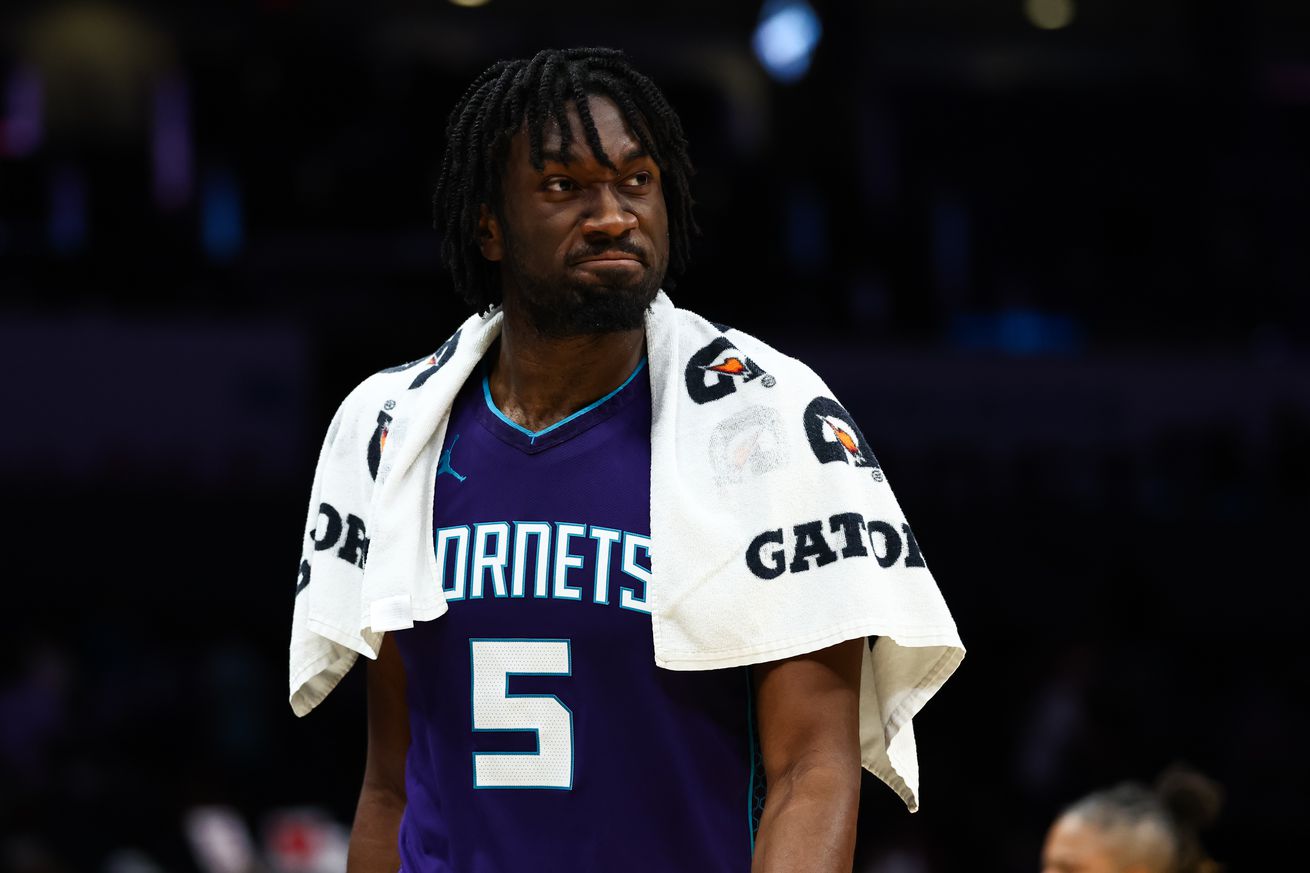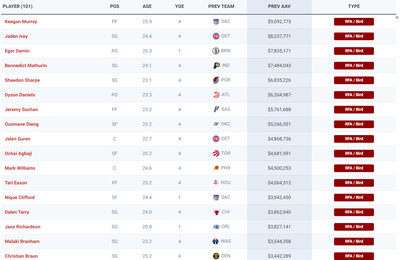
Mark Williams is walking into Phoenix with question marks but massive upside. So what is that worth?
One of the most significant acquisitions for the Phoenix Suns this offseason has raised many questions surrounding him as he enters his first season and future in the Valley. That would be the big man Mark Williams, whom the Suns traded for on draft night.
BREAKING: The Charlotte Hornets are trading center Mark Williams to the Phoenix Suns for the No. 29 pick tonight and a 2029 first-round pick, sources tell ESPN. pic.twitter.com/a6eDDn5aE6
— Shams Charania (@ShamsCharania) June 26, 2025
This deal involved sending Mark Williams to Phoenix in exchange for Vasilije Micic, the 29th overall pick in the 2025 draft (Liam McNeeley), and a 2029 first-round pick, which is the least favorable to the Utah Jazz, Minnesota Timberwolves, and Cleveland Cavaliers.
With this trade, the Suns were solidifying a major issue last season, their front court. By adding Williams via trade and drafting Khaman Maluach with the tenth overall selection, the Suns now doubled their center room in one night. Despite all the positivity, there is some skepticism about Williams for several reasons. That is where these questions arise, and this is where we break them down.
Is Mark Williams injury-prone?
This has been the main discussion surrounding the big man’s entire career.
In three seasons, he has totaled 106 games. An average of 35 games a season is not something to look at positively. Especially if you’re the Suns, who have dealt with an absurd amount of injuries in recent seasons, and that being a factor in hindering the best outcome for the team.
That being said, the Suns do see the potential in Williams when he is available. By also stacking this front court, hopefully it will not leave the Suns overly dependent on Williams and will allow him to play more throughout the season.
Last season, at the trade deadline, he was sent to the Lakers, but the trade was terminated by the team, citing injury issues they were unaware of.
Mark Williams’ physical with the Lakers showed multiple issues and the team failed him on the exam, sources tell ESPN. The physical was not failed due to his back, however. https://t.co/lY4XrSIlHf
— Shams Charania (@ShamsCharania) February 9, 2025
Williams has had injury concerns his entire career, so this was not a shock, but it was just a big question mark looming over his name. Regardless, the Suns did not care for that question mark and traded for him, hoping he could blossom in a new destination.
So can he?
I think so, and for one of the guys to take a flyer on at this position, he makes sense. Just confused on why they did not push for him at the last deadline instead of Nick Richards, if they were eventually going to replicate Charlotte’s center room.
My Answer
So is he injury-prone? I’d say his career has showcased that, and this is something to be wary of when evaluating the prospect. I would also not be surprised if there was something in the water down in Charlotte, and he is healthier than he was in the past, with more depth in this rotation.
Now, if Williams is playing and making an impact on how we all think he can, he will need to be locked up long-term. That raises the next question.
Is it smart to extend him this or next offseason?
This raises a significant question. The first thing to evaluate is how the salary cap increases every offseason. This offseason, it increased by 10%, the maximum allowed per offseason, with next year’s expected to be a 7% rise. Since salaries are rising, it would make sense that unrestricted players would be able to earn more money.
Sadly, Williams is not and is a restricted free agent. As we can see from this offseason, that is not a great place to be. Even though there are reportedly more teams with salary cap availability in free agency next season, that does not mean they will use it on RFAs.
Not to mention the restrictions of being an apron team, which limits the flexibility for a team’s future if a signing goes wrong, we have seen this come true this offseason with all the buyouts, which is why teams are hesitant to overpay these younger, impact players, as they are unsure whether it will trap or benefit them.
Looking at this class of RFAs, Williams also fits into that bill of players. One that is either good on one side of the ball and has question marks on the other, or one that hasn’t played enough to showcase what his role can genuinely be. This puts him and the Suns in a difficult spot this offseason.
When looking at the list of RFAs for next season, here is how Williams compares.

Now, some of these players could be extended before the season starts, including Williams. It will be widely expected that most of these teams retain their young players, and then maybe flip them down the road, as that has been the blueprint of free agency since the new CBA. That being said, with more money available in free agency, some teams may feel pressure to poach players from other teams.
The main takeaway from restricted free agency is that these players want to be paid more than what the team is willing to offer. That then raises the question of what Williams values himself at and what the Suns value him at.
My Answer
I think it would be smart for Mark Williams to negotiate a contract now, so that he could avoid the situation these other RFAs are in this offseason, but I think the Suns will not do that. They have yet to see Williams play, and making that investment could put you in another buyout situation down the line, something they want to avoid.
The Suns have all the leverage here, and if Williams does not pan out to what they thought, they can either offer him a cheaper deal or just let him walk. If he does turn out to be the real deal, as the Suns do think, then the question is whether you can retain him and for how much.
What should they pay him?
For someone who has only played in 106 games, his stats surprisingly showcase that, if available, he can be a top big man in this league. Even though he hasn’t fulfilled a full season each year, his averages have risen in points, assists, rebounds, blocks, and free-throw percentage.
In his career, he has averaged 12.3 points, 8.8 rebounds, 1.4 assists, and 1.1 blocks in nearly 24 minutes per game.
This season, he is expected to be more impactful in this rotation. With Jordan Ott and Brian Gregory having high praise for him, it seems that he will get those opportunities to shine as the starter in the beginning.
My Answer
I view Mark Williams very similarly to another big man in this league, Mitchell Robinson. Both have proven to be solid rim-protecting and rebounding bigs with injury concerns in their career that have stunted their full potential.
Although I believe Williams is better than Robinson, I would try to mirror this contract, as I think it would accurately represent his value. Robinson secured a 4-year, $60 million deal that scaled down over its duration. I don’t know if the Suns could get it down scale, but something similar scaled to this new CBA appropriation, I think, would fit.
When comparing other bigs’ AAV and looking at Williams’ value, it seems a deal worth $25 million would seem a bit high for his production so far. A four-year deal worth $18-22 million would make me feel good if Williams can showcase that he can be that dominant big. If not, then the Suns will luck out if they do not extend him and can offer an even cheaper deal next free agency.
I think a contract very similar to Jarrett Allen’s is also good to value Williams at if he does live up to that full potential. This would then put the Suns in a first-round situation, but if other moves do transpire beforehand, the Suns could still have the flexibility in their back pocket.
Final Thoughts
I like the acquisition of Mark Williams and think this is the ideal flyer for this type of Suns team to be looking for. If it pans out, they have someone to solidify a hole that they have noticed these past few seasons in their rotation. This will also make it easier for a guy in Khaman Maluach to develop and not be immediately thrust into the Suns’ starting spot with even higher expectations than now. If it does not work, the Suns took a risk and hopefully have the insurance of Maluach down the line to look forward to.
The value of the contract will probably be the biggest stopping point if he does not return, but if the Suns did trade for him and have these expectations, I’d expect them to comfortably pay him if he pans out, but most likely not before the season starts. Which could hurt them more if he does have an incredible season and raises his value. A double-edged sword, the front office has to evaluate and decide to act now or next offseason.
Listen to the latest episode of the Suns JAM Session Podcast below. To stay up to date on every episode, subscribe to the pod on Apple, Spotify, YouTube, YouTube Podcasts, Amazon Music, Podbean, or Castbox.
Please subscribe, rate, and review.
